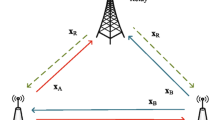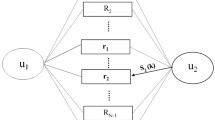Abstract
This paper studies code design for the half-duplex relay channel when the transmissions take place over binary input additive white Gaussian noise (BIAWGN) channels. Using the decode-forward relay protocol, we design the relay code based on a spatially coupled low-density parity-check (SC-LDPC) code. We show a low complexity density evolution analysis for the proposed relay code. From the density evolution results, we observe that the proposed spatially coupled relay code achieves a capacity approaching performance. We also observe that the proposed code outperforms existing optimized LDPC relay codes. Through simulation results, we evaluate the finite-length performance of the proposed code.





Similar content being viewed by others
Notes
Two extremes can be considered for relay coding strategy. In one extreme, s and r simultaneously transmit completely independent information. In the other extreme, s and r simultaneously transmit identical information. In [13], it has been shown that the latter strategy performs better than first extreme for low SNRs. Moreover, the latter strategy reduces the complexity at the destination [8].
For a given total power P and rate R, we calculate \(\frac{E_b}{N_0}\) by \(\frac{E_b}{N_0} = 10\log _{10}\frac{P}{2R}\) dB.
For a given total power P and rate R, we calculate \(\frac{E_b}{N_0}\) by \(\frac{E_b}{N_0} = 10\log _{10}\frac{P}{2R}\) dB.
References
Meulen, E. C. V. D. (1971). Three-terminal communication channels. Advances in Applied Probability, Vol. 3, no. 1, pp. 120–154, [Online]. http://www.jstor.org/stable/1426331.
Cover, T., & Gamal, A. (1979). Capacity theorems for the relay channel. IEEE Transaction on Information Theory, 25(5), 572–584.
Razaghi, P., & Yu, W. (2007). Bilayer low-density parity-check codes for decode-and-forward in relay channels. IEEE Transaction on Information Theory, 53(10), 3723–3739.
Azmi, M., Yuan, J., Lechner, G., & Rasmussen, L. (2011). Design of multi-edge-type bilayer-expurgated LDPC codes for decode-and-forward in relay channels. IEEE Transaction on Communications, 59(11), 2993–3006.
Ha, J., Kim, J., & McLaughlin, S. (2004). Rate-compatible puncturing of low-density parity-check codes. IEEE Transaction on Information Theory, 50(11), 2824–2836.
Hu, J., & Duman, T. (2007). Low density parity check codes over wireless relay channels. IEEE Transaction on Wireless Communication, 6(9), 3384–3394.
Chakrabarti, A., de Baynast, A., Sabharwal, A., & Aazhang, B. (2007). Low density parity check codes for the relay channel. IEEE Journal on Selected Areas in Communication, 25(2), 280–291.
Li, C., Yue, G., Wang, X., & Khojastepour, M. (2008). LDPC code design for half-duplex cooperative relay. IEEE Transaction on Wireless Communication, 7(11), 4558–4567.
Kudekar, S., Measson, C., Richardson, T., & Urbankez, R. (2010). Threshold saturation on BMS channels via spatial coupling. In Proceedings of International Symposium on Turbo Codes and Iterative Inform. Processing (ISTC), pp. 309–313.
Si, Z., Thobaben, R., & Skoglund, M. (2013). Bilayer LDPC convolutional codes for decode-and-forward relaying. IEEE Transaction on Communications, 61(8), 3086–3099.
Uchikawa, H., Kasai, K., & Sakaniwa, K. (2011). Spatially coupled LDPC codes for decode-and-forward in erasure relay channel. In Proceedings of IEEE International Symposium on Information Theory (ISIT), pp. 1474–1478.
Wei, L., Costello, D., & Fuja, T. (2013). Coded cooperation using rate-compatible spatially-coupled codes. In Proceedings of IEEE International Symposium on Information Theory (ISIT), pp. 1869–1873.
Chakrabarti, A., Sabharwal, A., & Aazhang, B. (2005). Sensitivity of achievable rates for half-duplex relay channel. In Proceedings Workshop on Signal Processing Advances in Wireless Comm., pp. 970–974.
Johnson, S. J. (2010). Iterative error correction: Turbo, low-density parity-check and repeat-accumulate codes. Cambridge: Cambridge University Press.
Felstrom, A., & Zigangirov, K. (1999). Time-varying periodic convolutional codes with low-density parity-check matrix. IEEE Transaction on Information Theory, 45(6), 2181–2191.
Kudekar, S., Richardson, T., & Urbanke, R. (2011). Threshold saturation via spatial coupling: Why convolutional LDPC ensembles perform so well over the BEC. IEEE Transaction on Information Theory, 57(2), 803–834.
Si, Z., Thobaben, R., & Skoglund, M. (2012). Rate-compatible LDPC convolutional codes achieving the capacity of the BEC. IEEE Transaction on Information Theory, 58(6), 4021–4029.
Noor-A-Rahim, M., Lechner, G., & Nguyen, K. D. (2016). Density evolution analysis of spatially coupled LDPC codes over BIAWGN channel. In Proceedings of Australian communication theory workshop (AusCTW).
Acknowledgments
This work was supported by the Australian Research Council Grant DE12010016.
Author information
Authors and Affiliations
Corresponding author
Rights and permissions
About this article
Cite this article
Noor-A-Rahim, M., Nguyen, K.D. & Lechner, G. SC-LDPC Code Design for Half-Duplex Relay Channels. Wireless Pers Commun 92, 771–783 (2017). https://doi.org/10.1007/s11277-016-3576-2
Published:
Issue Date:
DOI: https://doi.org/10.1007/s11277-016-3576-2




